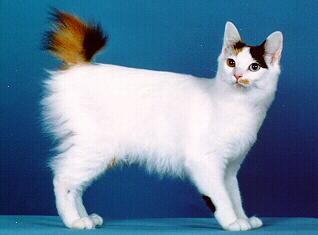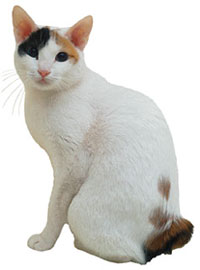The History and Biology of the Japanese Bobtail Cat
The Japanese Bobtail is most well known for its unusual tail. The cat’s tail has a distinctive bobbed appearance which almost looks like that of a rabbit. This unusual bobbed look is where the breed gets its name.
A history of the Japanese Bobtail
Like many breeds of cat, the Japanese Bobtail has had a close relationship with farmers. In European countries this typically took the form of barn cats. They were used by farmers of all sorts in Japan as well. But the biggest difference came about in 1602. The surrounding years had seen damage to the valuable silk worms of the area. Various rodents had been causing serious problem to people involved with the silk trade. A new law was passed in an attempt to put a stop to the rodents.
In 1602 it became illegal for people to own house cats in Japan. The law had the intended effect, and a small army of cats was suddenly free to roam the streets. They made quick work of the invading rodent population. Eventually the law was revoked and people were free to keep cats within the home again. It’s theorized that this allowed people to select for some of the tamest and laid back cats. While nobody can be certain, it’s probable that people decided that cats with bobbed tails were particularly docile. This led to those cats with this unique mutation getting an early advantage over their peers.
This selection, and later selective breeding, might have been the origin of the Japanese Bobtail Cat. Because a hundred years later Kaempfer’s Japan gave Westerner’s their first description of the species in Japan. It reported the Japanese Bobtail as the norm in Japanese households. It also mentioned the fact that they were notable for their affectionate and laid back nature.
It would take a surprisingly long time to make its way out of Japan. No records exist of someone from the West owning a Japanese Bobtail cat until 1968. The first example of this import to the West came about from Elizabeth Freret. It didn’t gain full recognition as a competitive breed until the mid 70s. In 1976 the short hair Japanese Bobtail was accepted by the Cat Fanciers Association as a Championship breed.
Appearance of the Japanese Bobtail Cat
The Japanese Bobtail is, of course, most notable for its tail. It received its name because it has a distinctive bobbed tail. To qualify as a Japanese Bobtail the cat must have a tail which is both plainly visible and made up of curved articulations. The rabbit-like appearance is further accentuated by large and highly upright ears.
Biology of the Japanese Bobtail cat
 On a genetic level, the breed is defined by a particular mutation in a recessive gene. This means that two Japanese Bobtails will always produce a kitten with the same body type. However, it’s very unlikely for a Japanese Bobtail to produce another of that type when mating with another breed of cat. It would be especially rare outside of Japan. Within that country the gene has propagated into more of the cat population as a whole. In Western countries it’s largely only present within the Japanese Bobtail population.
On a genetic level, the breed is defined by a particular mutation in a recessive gene. This means that two Japanese Bobtails will always produce a kitten with the same body type. However, it’s very unlikely for a Japanese Bobtail to produce another of that type when mating with another breed of cat. It would be especially rare outside of Japan. Within that country the gene has propagated into more of the cat population as a whole. In Western countries it’s largely only present within the Japanese Bobtail population.
The propagation of the gene in Japan for such an extensive period has also led to an above average level of biodiversity. Many newer breeds come with associated illnesses. The Japanese Bobtail, however, is considered one of the healthiest and genetically diverse pedigree breeds. The only medical oddity that comes with the breed is a slightly higher level of heterochromia than other breeds. This means that the cats might have eyes of two different colors. However, this is a purely cosmetic trait and has no bearing on the actual health or eyesight of the cat.
 Types of Japanese Bobtail cat
Types of Japanese Bobtail cat
There’s little variation within the commonly accepted standards for a Japanese Bobtail cat. The biggest differences will be found with color. White calicoes are considered the ideal for the breed. But any combination of coat and pattern is acceptable within the breed.
Personality of the Japanese Bobtail cat
The Japanese Bobtail was originally selected for by Japanese homeowners looking for human friendly breeds. This might be why they have a strong tendency to take to various human centric activities. Most cats, for example, have a difficult time adapting to a leash. A Japanese Bobtail cat will typically take to walking on a leash far more easily. They also have other, similar, traits which are often associated with a more lengthy domestication. One of the more easily noted is a propensity for human audible vocalization. The breed usually enjoys making a variety of different meowing noises at people. The wide range of tone has actually led to popular folktales in Japan of the cat being able to sing.
Leave a Reply